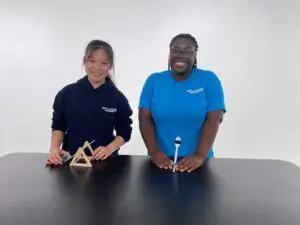- Masking tape
- Scissors
- String or yarn
- Water balloons (2), fully filled
- (Optional) Mobile device for video recording
- Variety of building materials that you have on hand (you don’t need everything on the list), such as:
- Air pillows or bubble wrap
- Cardboard boxes, small
- Coffee filters
- Craft sticks
- Egg cartons
- Newspaper
- Packing peanuts
- Paper bags
- Pipe cleaners
- Plastic bags (different sizes and weights)
- Plastic containers
- Straws
What happens if you drop a water balloon from a height of 25 feet? Is there any way to prevent it from bursting? In this challenge, you’ll use everyday materials to design a way to land a water balloon, undamaged, from a height of 25 feet—about the same height as a second-story window or balcony. Be sure to get permission from a parent or guardian and ask them to help you find a good location for testing.
Here are the engineering constraints for this challenge:
- The balloon must be completely filled with water.
- The water balloon must be dropped from a height of approximately 25 feet (i.e., dropped from a second-story window or balcony).
- The water balloon must be dropped onto a hard surface (i.e., concrete, asphalt, sidewalk).
To be successful, your design must meet the following criteria:
- The water balloon is undamaged after its fall.
Brainstorm
Materials engineers develop and test different types of materials. Sometimes they look for ways to reduce air resistance, or drag, so a product moves faster or more efficiently. Other times, their goal is to increase air resistance, or create drag, to purposefully slow an object down.
Your challenge is to design a way to keep a water balloon from bursting when dropped from a height of approximately 25 feet.
- Watch the Challenge Video for inspiration and to review the parameters of the activity.
- Figure out the logistics.
- Find a location for the balloon drop that is about 25 feet high, such as a second-story window or balcony. Make sure the area below is free of cars, bicyclists, pets, and people. (You don’t want anyone to accidentally get struck by a falling water balloon!)
- Ask a friend to help you with the drop. Your friend can remain on the ground to keep the area clear and even record your balloon drop on video.
- Before you start brainstorming designs, think about what you already know. Consider:
- Is there anything you could do to prevent the balloon from bursting when dropped? What ideas do you have?
- What is gravity? How does gravity act on the balloon?
- What do you know about air resistance, or drag? Can you use the idea of drag to prevent the balloon from bursting?
- How might you cushion the balloon as it hits the ground?
- Take a look at your materials. Think about which materials might be useful as you consider gravity and air resistance.
- Sketch some designs or jot ideas.
Build, Test, Redesign
- Choose your best idea and build a prototype. A prototype is a model or something you build that shows your idea.
- Make a prediction about how your prototype will work and explain your thinking.
- When you’re ready, take your friend and go to the drop zone. Make sure there aren’t any cars, bicyclists, pets, or people when you drop your balloon. If you have a mobile device, ask your friend to make a video of your balloon drop.
- Did you meet the success criterion? If not, make changes to your prototype and try again.
Reflect
- What did you like and dislike about the challenge?
- What problems did you have when building, testing, and redesigning?
- How did you use the concepts of gravity and drag in your design?
Review the success criterion. Did your design meet it? Nice job! Share your results with a family member, teacher, or DiscoverE! You can also share photos and videos on social media and tag @DiscoverEorg.





6 Comments